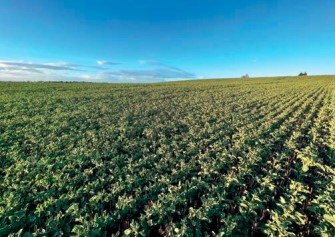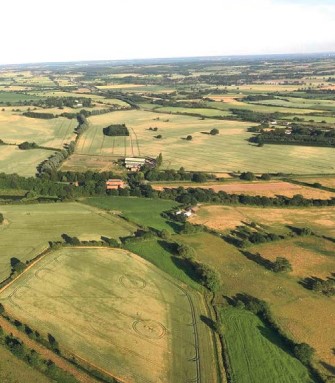
Risky business
The financial results are in, and they are good, in fact some of the best of my farming career to date. It would be wonderful now go on to describe how that is all down to the huge savings in fixed and variable costs made through our transition to a zero tillage, regenerative farming system, although that certainly contributes to the results it would only really be telling a part of a far simpler story. The truth is the financial performance was really because of just 2 key decisions, buying inputs (particularly nitrogen fertiliser) and selling outputs at the right time. So, did I make money farming or trading? And which is higher risk? Farming or trading? How we look at and deal with risk is something that is a key driver to many of the decisions we make within our farming business and something I think everyone should explore their attitude towards.
As farmers we grew the crops, we took the risk with weather, put in the hours and were rewarded with a decent harvest, no record breaker but certainly on par and budget for our soil type. As farmers I’m not sure we always realise it but there is great risk in what we do, my father has said in the past “there will always be a harvest” and this is certainly true in the UK but many who farm under climates more extreme than our own will understand this is not always the case. As a result, farmers in such countries seem much more aware of the risk of planting a seed with nothing more than hope of harvest and adjust their investment accordingly to mitigate this.
Weather related risk, be it drought or flood is something that British farmers have enjoyed lower exposure to, unlike many others. In the UK a drought is usually measured in weeks, maybe months, in places like Australia however it’s a question of years. The British are world renowned for obsessing and talking about our weather but in truth its nothing that extreme, making our exposure to weather risk some of the lowest in the world.
Yet most people I speak to seem to agree that our weather patterns do seem to be changing, climate change is becoming very real and whilst politicians and scientists talk about it, farmers are on the front line of that change. I’m not convinced the numbers tell the real story, looking at statistics for average rainfall and temperature in my area it seems little of significance has really changed, so why does it feel like windows to establish, harvest and spray are shorter than ever despite us having better technology and capacity than we did in the past?
The numbers don’t reflect the patterns, the weather seems to get stuck in cycles of wet or dry. The autumn and winter of 2019 were the wettest I can recall farming through, establishing crops was extremely difficult and impossible for many the wet pattern lasted months and then as to add insult to injury was followed by a very dry spring / early summer during which we went 90 days without rainfall, a perfect storm of events which resulted in a lower yielding poor harvest 2020. We can’t control the weather, but I do believe we can mitigate the risk. Our move from a 6m drill to a 12m version for instance almost doubled our establishment capacity, reducing the length of window required for establishment, a move from 24m to 36m tramlines also had similar effect upon application timeliness and were both achieved whilst reducing costs and only really possible as a result of the lower horsepower requirements that no tillage bought to our farm. Regenerative farming systems typically are far more diverse in their cropping and rotation meaning all the eggs are never in one basket whilst spreading establishment, application and harvest timings.
Most importantly of all, however, is that building soil biology then changes soil structure and its ability to manage water. There is no doubt in my mind we suffer less from drought on our lighter soils that we used to, better structure and microbiological activity not only is more efficient and able to supply plants with the nutrition they need it is also important to the supply of water directly to where it’s needed. The image below shows 2 images taken the same day in July 2017 from a drone following several weeks without rain, the first is looking over our wheat, the second after turning the drone 180 degrees looks over neighbouring wheat, I think it is clear which crop is better supplied with water despite similar soil types, the only major difference being over a decade of no tillage vs a more conventional plough based system.

Lack of water isn’t always the problem, too much when you want to establish a crop can be equally disastrous. Again, no till certainly seems to reduce this risk and open larger windows for activity with cover crops providing a green bridge to drill upon isolating wheels and coulters from wet soil beneath and improved structure that builds over years on no cultivation rewards with huge networks of vertical worm galleries helping move excess water to drains and subsoils more efficiently.
Agronomically, I have no doubt that our no tillage, regenerative agriculture system has reduced our risk but that’s only really part of the story here.

Recent, tragic events in the Ukraine have caused chaos in commodities markets, the effect on oil and gas prices has seen red diesel rise to circa £1.25/L at time of writing. A big horsepower tractor working hard on cultivation can get though as much as 1600L of fuel a day, that’s enough fuel to establish about 1000ac without cultivation! Looking back at records from when we did cultivate every acre, we used 32L/ha of fuel to establish crops, today that number is closer to 4L/ha. The increase in fuel cost has increased the capital required to plant a crop, the stakes are higher no matter what your farming system is but the rise is far more significant if cultivating that if you are not, I honestly do not know how farmers stuck in the high horse power cultivation treadmill are going to justify burning through so much fuel this coming autumn, where will that extra margin required come from?
Fuel is just a sideshow however compared to the rises in synthetic fertiliser costs, nitrogen is now almost £1000/t, a 4-fold increase upon last year’s price yet with new crop wheat prices just 70% up. These are game changing numbers and although some are keen to point out that margin over input costs still makes application viable margins have been eroded, capital requirement increased and importantly risk yet again has grown. I have little doubt this will result in much lower planting of nitrogen using crops like wheat, barley and Oilseed rape this autumn. These are the high output crops that support high input farming system with high fixed cost burdens, take away the output and you are heading for financial trouble fast unless you can make rapid adjustments to your fixed cost structure.

Anything that can help reduce dependence upon synthetic fertilisers is now essential. Cover crops that can fix nitrogen are suddenly of greater value and interest to man. Diversity of rotation to include more pulses will look more attractive potentially causing oversupply in those markets, nutrient loss via offtake of crop residues and importing FYM and composts will become of greater focus. Of course there will be no shortage of products that claim to replace the need for synthetics, which some may well do but also many mostly probably will need time to provide proof via trials. For some on more marginal land fallow may become a better option than cropping, an option without output that really is only viable or something that a low fixed cost business can entertain. I don’t think the Ukraine situation is something that will see rapid resolution so just maybe the certainty of entering environmental schemes could suddenly look a lot safer bet.
The farmers that have already moved to lower fixed cost, lower inputs systems are by far the best placed to deal with these extremely uncertain times, they have already built more resilient farm businesses both agronomically and financially. I could make a good argument that now is the time to reap the rewards of change but in such a volatile market the truth is profit or loss is far more likely to being down to those 2 same thing that have yielded me such a good year, buying and selling at the right time. In summary, manage and minimise risk it’s what good business is all about, but more importantly be a trader, it’s likely to make more difference than pretty much anything else you do today.